Samsung The Frame 2025 is a TV like no other – and even though it has competition now, it still does it best. The matte panel, flush with the wall, and one thin cable thanks to the One Connect module make the device resemble a piece of art more than any other screen. The Art Store app continues to offer the best scans of artworks on the market (even if they are subscription-based), and with interchangeable frames, we can match the TV to the interior almost like furniture. When it comes to the picture itself, because after all, we are also talking about a regular TV, there are no major changes, but also no disappointments compared to last year's model LS03D. The Frame still offers high native contrast and solid brightness at 600 nits, which combined with the matte coating provides very comfortable daytime use. The colours are not as vibrant as in glossy screens, but compared to competitive matte constructions – they fare the best. A novelty is the 144 Hz refresh rate, though in practice it will mainly benefit PC gamers. And indeed – in terms of features for gamers, The Frame has nearly everything: low input lag, support for variable refresh rate (VRR), automatic game mode (ALLM), Game Bar, and a unique motion smoother designed for gaming. Unfortunately, not everything is as perfect as it might seem. Why? Because the HGiG mode is missing, which suddenly disappeared from the latest version of the Tizen system. And here Samsung really should respond, as for many gamers this is a key element in choosing a screen. And we fully understand that. Although LS03F The Frame 2025 does not bring major revolutions, it is still a unique TV that, aside from its appearance, offers a quite solid picture and advanced gaming features. It’s just a pity that year after year we also receive new compromises.
- Matching (Score)
- Our verdict
- TV appearance
- Where to buy
- Contrast and black detail
- HDR effect quality
- Factory color reproduction
- Color reproduction after calibration
- Smoothness of tonal transitions
- Image scaling and smoothness of tonal transitions
- Blur and motion smoothness
- Console compatibility and gaming features
- Input lag
- Compatibility with PC
- Viewing angles
- TV efficiency during daytime
- Details about the matrix
- TV features
- Apps
- Playing files from USB
- Sound
Samsung The Frame 2025 (LS03F) vs TCL C9K
Direct compare
The Frame / LS03FAU
C9K

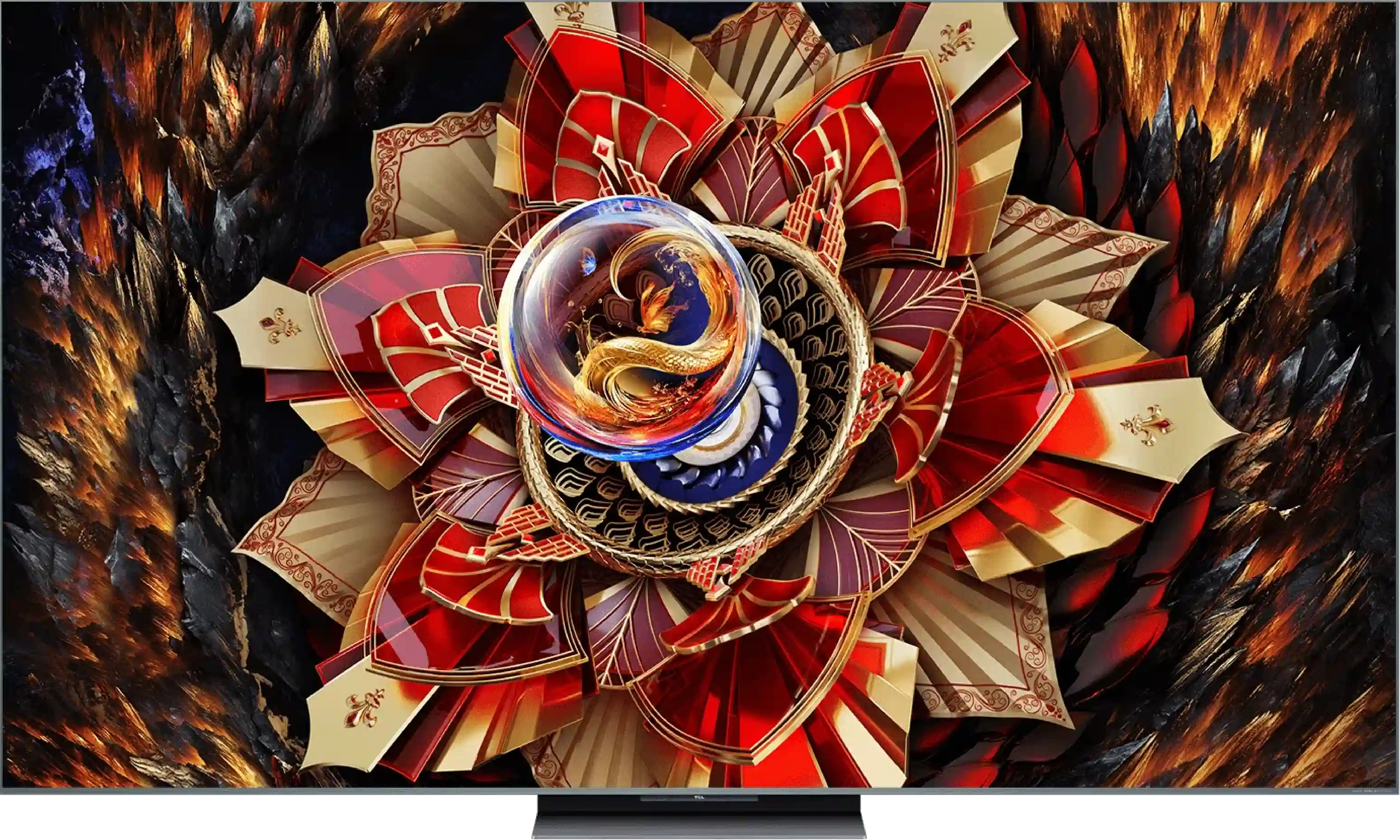
Panel type: LCD VA
Resolution: 3840x2160
System: Tizen
Model year: 2025
Complete the survey to find out the result

Panel type: LCD VA
Resolution: 3840x2160
System: Google TV
Model year: 2025
Complete the survey to find out the result

Overall rating
7.0
7.7
Movies and series in UHD quality
6.8
7.4
Classic TV, YouTube
6.5
7.0
Sports broadcasts (TV and apps)
6.4
6.8
Gaming on console
8.3
8.9
TV as a computer monitor
8.2
8.6
Watching in bright light
6.3
7.0
Utility functions
7.2
7.7
Apps
8.7
9.6
Sound quality
6.0
7.9
Complete the survey to find out what fits your preferences
Advantages
Matte panel effectively reduces reflections
Screen customisation option with interchangeable frames + art mode
Free add-ons including wall mount + OneConnect module
High native contrast
Good brightness
High refresh rate - 120/144Hz
Plenty of features for gamers - VRR, ALLM, Gamebar, proprietary motion smoother functioning in games
Very good contrast and black levels
Very high brightness
Support for all HDR formats including Dolby Vision
Fast 144Hz panel - for gaming and sports enthusiasts
Many features for gamers: VRR, ALLM, low input lag, etc.
GoogleTV operating system with a wide range of applications
Great sound branded Bang & Olufsen
Improved viewing angles thanks to WHVA panel
Disadvantages
No HGiG mode – makes precise HDR settings on the console difficult.
No DTS support – requires additional equipment for some films on Bluray discs.
Paid picture mode
Local dimming needs improvement
Only 2 HDMI 2.1 ports
No recording function from built-in tuners and no PiP
No smaller variants like 55"
Our verdict
The TCL C9K is a television that on paper looks like a showcase of the manufacturer's prowess – thousands of Mini-LED zones, a WHVA panel, audio system by Bang & Olufsen, full HDR format support, gaming at 144 Hz, and even 288 Hz at lower resolutions. It’s clear that TCL wanted to pack in absolutely everything they had that was best. And indeed – in many respects, the C9K can impress. The brightness is immense, HDR can be stunning in larger scenes, motion fluidity and gamer capabilities are at a top level, and the sound – for a TV speaker – sounds really good. It’s equipment that can easily be regarded as the hub of home entertainment. But there's also another side to the coin. Brightness management simply falters despite the incredible technical specification – smaller details often get lost in shadows or are burned out. And although synthetic tests of contrast and brightness appear outstanding, in day-to-day watching of films and series the effect isn't as impressive.
To summarise briefly: the C9K is a television full of contrasts – literally and metaphorically. It can deliver experiences close to the top screens, but it’s still clear that TCL needs to work on software and optimisation. If someone is looking for a screen for gaming, sports or spectacular blockbusters – they will be thrilled. However, if they are counting on perfect reproduction of the director's vision and think they have managed to buy an absolutely top model at half the price of the competition, they will unfortunately be disappointed. It’s a pity, because the technological potential here is really immense – just a bit of common sense in its application was lacking.
TV appearance





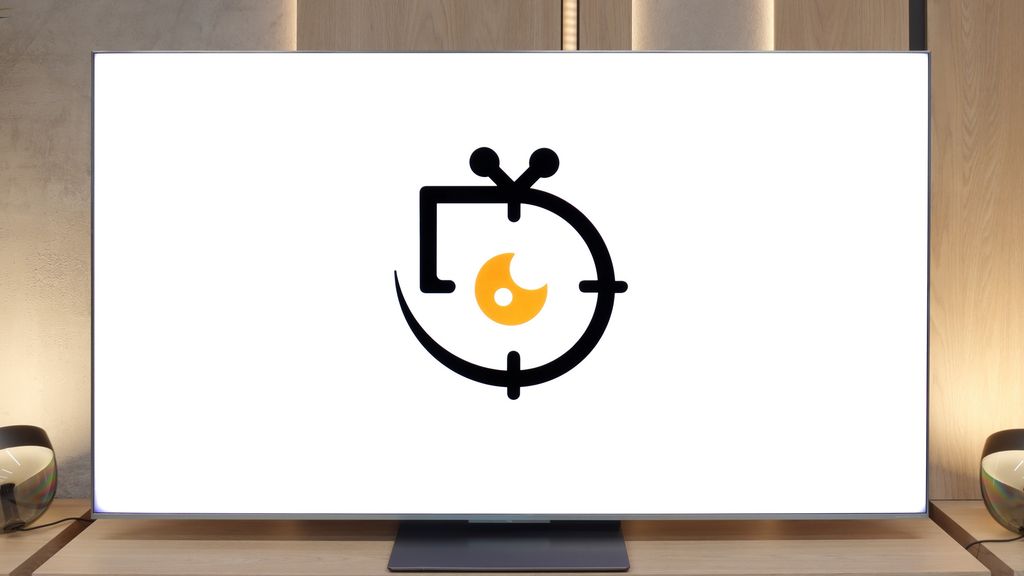
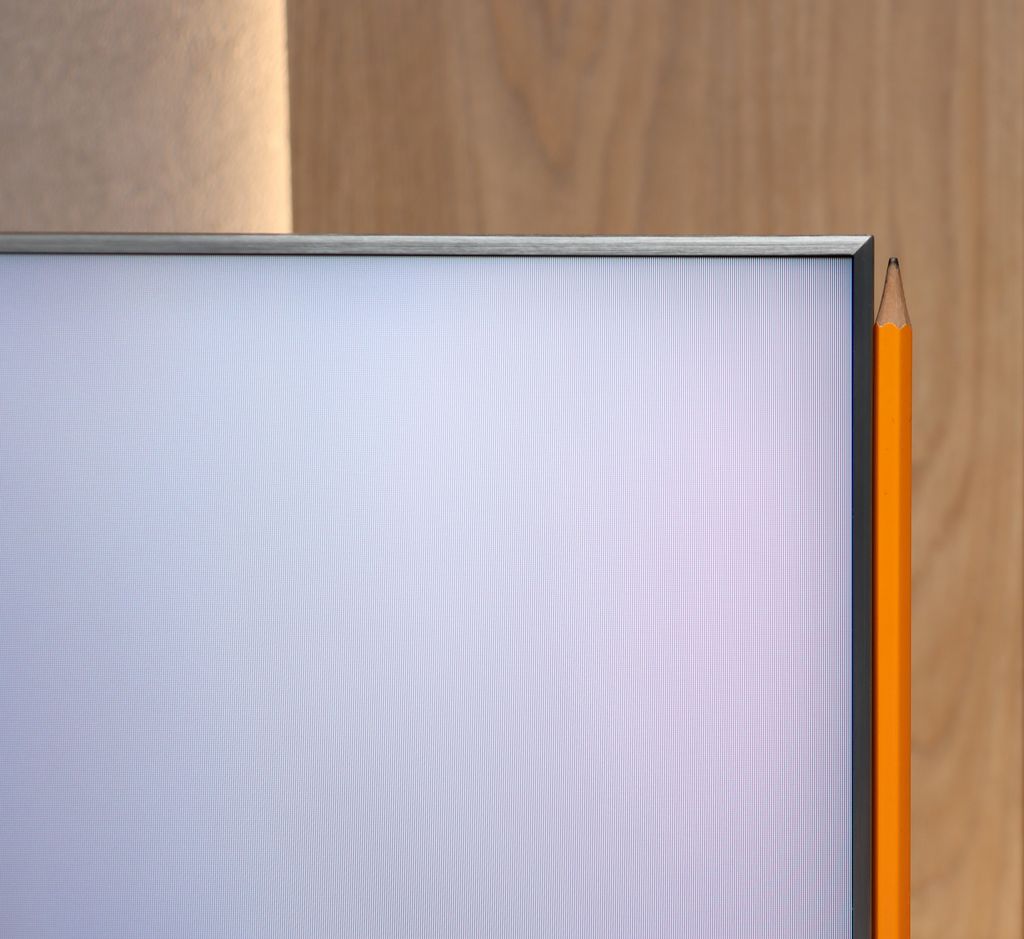
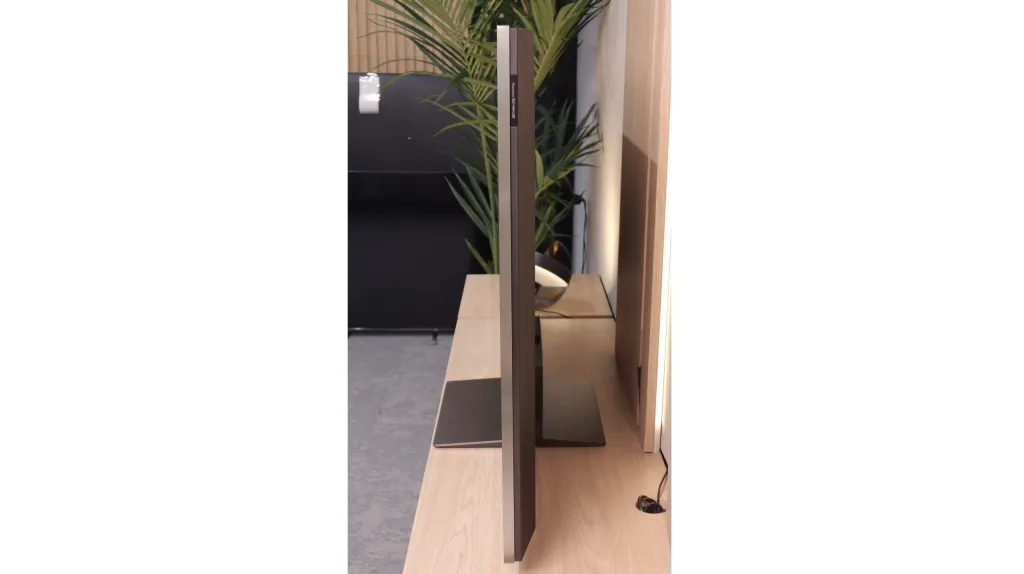
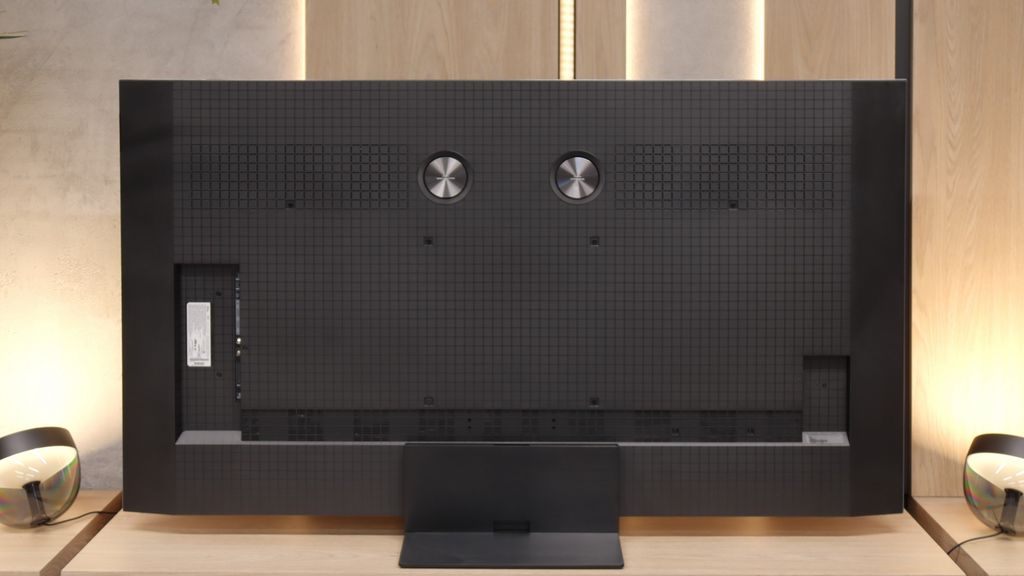
Contrast and black detail
6/10
8.1/10
Local dimming function: No
Local dimming function: Yes, number of zones: 3024 (42 x 72)
Contrast:

Result
4,800:1

Result
4,750:1

Result
14,900:1

Result
4,500:1

Result
4,300:1

Result
459,000:1

Result
72,750:1

Result
30,350:1

Result
9,800:1

Result
12,200:1
Halo effect and black detail visibility:

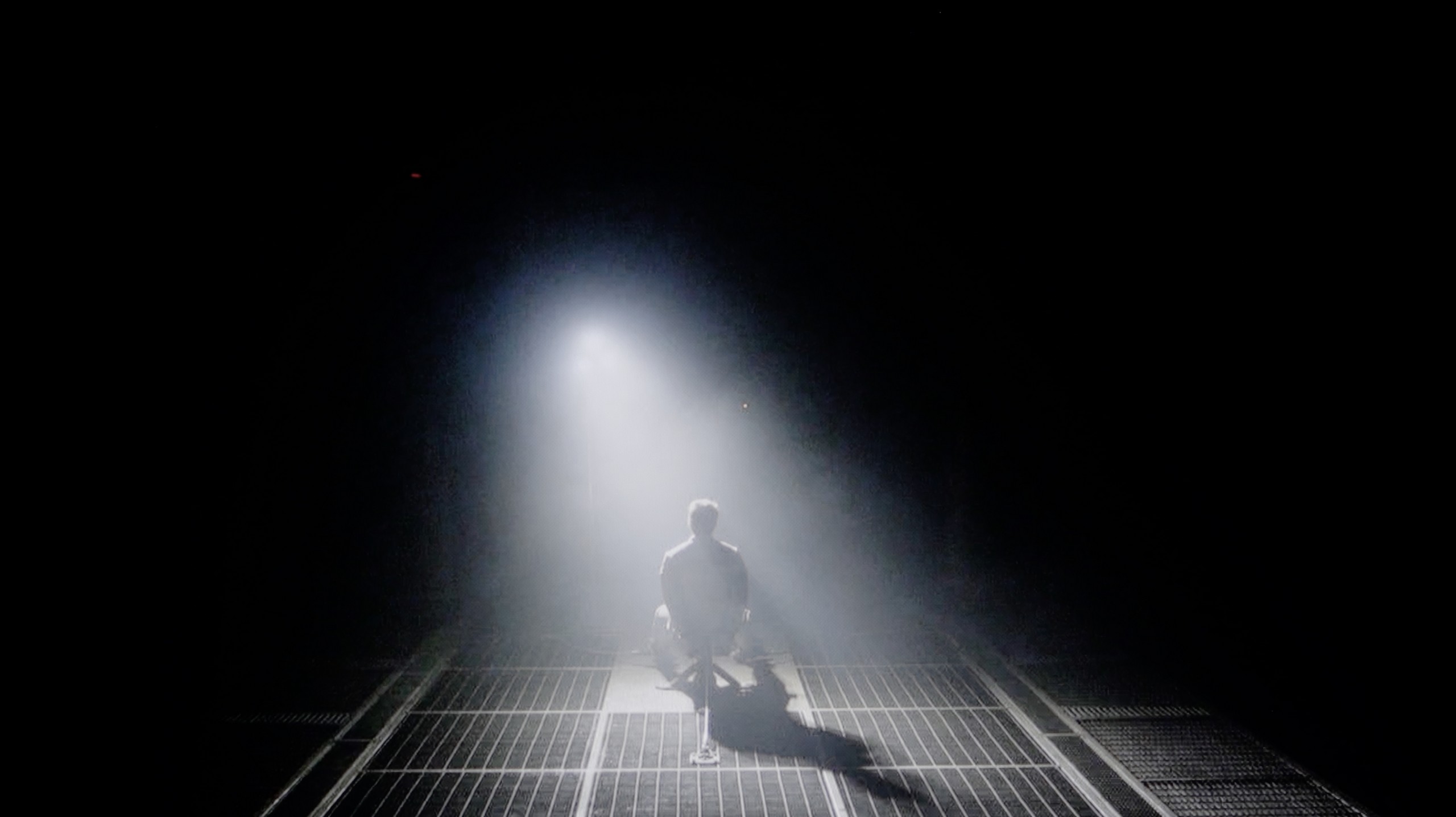
The year 2025 is shaping up to be quite interesting when it comes to lifestyle televisions. Why? Because Samsung has prepared two versions of the iconic model The Frame – one standard and the other with the addition of "Pro". In this review, we take a look at the version without "Pro", which – as we will soon see – makes a significant difference. The standard model LS03F lacks any local dimming technology, unlike its more expensive sibling. This is important as it affects not only the overall picture quality but primarily how this television handles black levels.
The VA panel used in The Frame 2025 has a high native contrast – and this obviously works in its favour. In the tested movie scenes, details in the dark areas of the image were well visible, nothing blended together, and there was no uniform black/light blob. For the average viewer, this will be perfectly sufficient. But of course, not everything is ideal. The lack of local dimming means that the black levels on this television are not perfectly deep – they resemble a dark navy blue rather than pitch black. Additionally, in our tested unit, we noticed slight blooming on the right side of the screen, but this may simply be the "character" of the unit rather than a rule. Theoretically, one could try to improve the perception of black by backlighting the screen – for example, with an LED strip – but in the case of The Frame, that’s rather impossible, as this television is meant to sit flush against the wall like a piece of art. So to achieve better blacks visible to our eyes, we are forced to watch LS03F with the lights on. Such is the charm of this technology.
What immediately sets the C9K apart from the C8K model is the number of local dimming zones. In the 65-inch version, we counted… over 3000! I must admit – it’s a true show of force from TCL, who crammed literally everything they had on hand into this television. On paper, it makes a huge impression and indeed – in less demanding film scenes, the blacks look fantastic. The level is absolutely top-notch, and the separation of lights from dark parts of the image can be astonishing. The problem is that this impressive specification doesn’t always translate into practice. In our tests, we noticed situations where the C9K, despite having a greater number of zones, got caught in contrast traps and performed… worse than the C8K. For instance, it struggles to perfectly dim the true black bars in 21:9 films (those with black bars at the top and bottom). Sounds strange? Unfortunately, this is the result of a lack of optimisation – the hardware is “packed” with technology, but the algorithms don’t always keep pace with exploiting this potential.
Don’t get us wrong – black is a strong point of the C9K and in many scenes, it simply looks fantastic. In synthetic measurements, the contrast performs exceptionally well, coming close to the level of the best televisions on the market. But in real cinematic use, these numbers don’t always correlate with a better experience than that of its cheaper cousin. And that’s perhaps the biggest disappointment – because the potential was enormous.
HDR effect quality
6/10
6.9/10
Luminance measurements in HDR:

Result
642 nit

Result
589 nit

Result
574 nit

Result
584 nit

Result
631 nit

Result
1425 nit

Result
531 nit

Result
1277 nit

Result
331 nit

Result
1424 nit
Scene from the movie “Pan” (about 2800 nits)


Scene from the movie “Billy Lynn” (about 1100 nits)


Static HDR10


Dynamic: HDR10+
Dynamic: Dolby Vision


HDR luminance chart:
TCL C9K
Luminancja HDR
Luminance of RGB colors
Samsung The Frame 2025 (LS03F)
Luminancja HDR
Luminance of RGB colors
The Frame LS03F is a television that can surprise with its brightness. The maximum luminance reaches around 650 nits, which already looks solid on paper. But as we know – lab tests are one thing, and real film scenes are quite another story. When watching HDR materials in natural conditions, The Frame 2025 maintains very good results. In most film scenes, peak brightness stayed at around 550–650 nits. This is enough to feel the difference between standard picture and that in HDR quality – bright highlights, reflections on water, or moonlight look distinct and impressive.
It's also worth noting that the LS03F is a QLED television, which translates to solid colour saturation. The coverage of the DCI-P3 colour space reaches about 92%, allowing for vibrant, intense colours in HDR content. It's not at the level of top premium models, but for a lifestyle screen – the result truly deserves recognition.
As we mentioned regarding black levels and contrast – the C9K can make a huge impression in synthetic tests. Our measurements showed that on a screen 10% filled with white, the television can achieve... 4000 nits of brightness! It sounds out of this world, but – and here's where the pattern unfortunately repeats – the numbers say one thing, and the practical experience says another. In real movie scenes, the situation looks different. In the best-case scenario, when light effects occupy a large part of the image and the local dimming algorithm doesn't have to ponder too much about what to do with thousands of zones, the effect is really quite good. At that point, the C9K can hit around 1500 nits, which delivers a pleasant, intense burst and can indeed leave a positive impression.
The problem arises with smaller elements – such as stars in the sky, the moon, or individual reflections. That's when the proverbial cat comes out of the bag: the algorithms are not yet refined, and brightness drops to as low as 400–500 nits. That's a huge difference from the potential 4000 nits we saw in lab tests. Why does this happen? Most likely, the television is trying to protect the black levels in this way and minimize the halo effect around bright objects. Unfortunately, this comes at the expense of detail – some details simply vanish, and the scene loses its nature.
Factory color reproduction
7.1/10
4.5/10


Factory Mode
After calibration


Factory Mode
After calibration
When it comes to picture quality right out of the box, even in Filmmaker mode, which is supposed to be the closest to reference, there were some issues. In both HD and 4K HDR content, we noticed clear deviations in white balance. The picture was heavily skewed towards red and blue, giving the screen a distinctive pinkish hue. This effect was most noticeable in bright scenes – for example, in shots with a lot of white, where neutral light should naturally dominate. In such moments, the screen clearly took on pink tones, which is also evident in the attached comparative photo. As for brightness characteristics – it wasn't as bad as one might expect given such colour inaccuracies. Analysis of the gamma curve and EOTF showed a slight brightening of the image compared to the reference, but not enough to drastically spoil the viewing experience.
For colour tests, we once again reached for the Filmmaker mode – a new feature in TCL televisions for 2025. While the direction is a step in the right way, the execution leaves a lot to be desired. The white balance in SDR content turned out to be too warm – there was an excess of red. On the other hand, in HDR, it swung in the opposite direction: the image became excessively blue. The Colour Checker test revealed quite a few colour inaccuracies that were noticeable to the naked eye. An even bigger problem turned out to be what we mentioned above – brightness management. Regardless of whether we were watching SDR or HDR content, the image tended to wash out the entire scene, giving it an unnatural, almost grotesque character. Therefore, it’s hard to call this a "director's mode" – because no director has ever seen such an image.
Color reproduction after calibration
8/10
7/10




After calibration, the movie mode gained a completely new quality. The issue of the pink tint, which was previously clearly visible, especially in bright scenes, has been effectively eliminated. Colours started to look significantly more natural, and the white balance no longer dominated the rest of the image. It was no longer the same oversaturated "picture from a box" – everything took on coherence and a cinematic character. Additionally, the tendency of the TV to slightly brighten scenes, previously visible in the EOTF curve analysis, has been partially corrected. Of course, within the limits of what the design allows without local dimming – it's difficult to speak of perfect brightness management here. Nevertheless, the final effect was definitely closer to what one might expect from a mode named Filmmaker.
After calibration, we finally managed to tame the white balance – and it immediately translated into a more natural image. Colours finally started to look as they should, and the overall presentation was incomparably better than on the factory settings. In other words – it’s worth taking a moment to improve this, as the gain is really significant. The gamma responsible for brightness management also managed to be brought into order in SDR content, and the effect was more than satisfactory. Unfortunately, when we turned on HDR materials, the situation quickly became complicated. No matter how we set the local dimming, the television had a tendency to do what it liked with the image – either it overexposed everything or darkened the darkest parts too much. Just like we saw in the scene from the movie Billy Lynn. Colour-wise, the improvement after calibration makes a great impression, but brightness management in HDR remains the Achilles' heel of the C9K and presents a certain technological limitation.
Smoothness of tonal transitions
9/10
8.7/10












In terms of the smoothness of tonal transitions, the LS03F maintains a high standard – just like last year's models. The television didn’t have any issues during testing of more challenging film scenes, where visible transitions between shades can easily occur. The colour gradation performs very well here – both in lighter and darker parts of the image. We did not observe the typical banding effect or any other disturbances that could be noticeable while watching films. If we were to nitpick, in the most demanding scenes – with subtle transitions and delicate gradients – minor imperfections can be seen. But only if you get really close to the screen and start analysing the image from an unintended distance.
In terms of tonal transition fluidity, TCL C9K performs quite well. In more challenging movie scenes, there's no typical banding of colours that can break immersion even in more expensive TVs. There may be slight issues in the brightest areas – for example, in scenes from the movie Kingstone – but these are nuances. For the vast majority of viewers, especially with 4K content, colour gradation will appear smooth and practically unnoticeable.
Image scaling and smoothness of tonal transitions
6.7/10
5.5/10
Smooth transition function

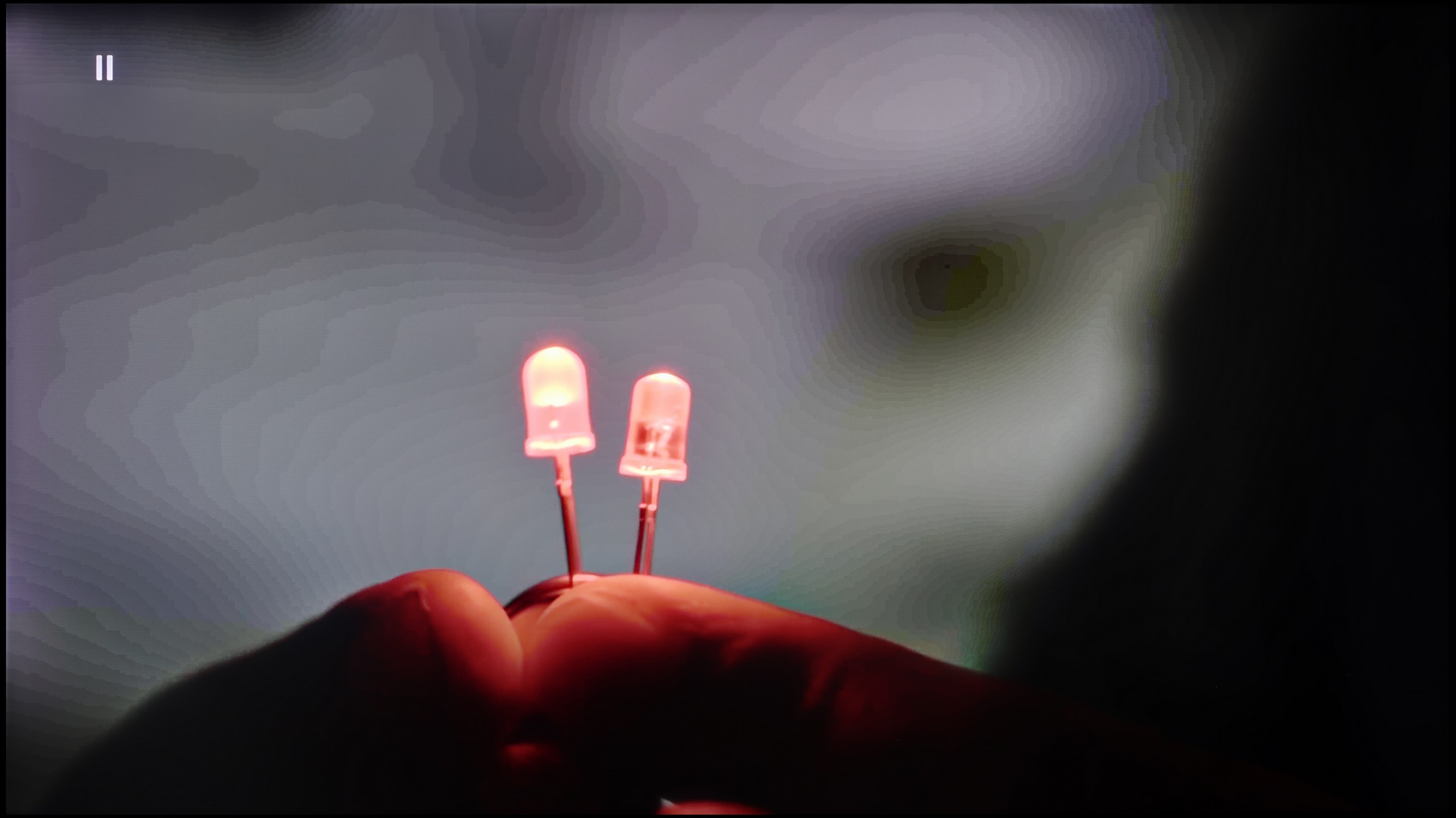
Image without overscan on the SD signal


LS03F is equipped with an NQ4 processor, which is responsible for improving image quality – especially in lower-quality materials. In practice, it works surprisingly well, particularly when it comes to older content and recordings with lower resolution. Activating the "noise reduction" feature delivers noticeable results. The television effectively smooths tonal transitions and removes digital noise that can appear in darker areas of the image. Compared to previous generations, there is a clear improvement – earlier, this feature often smoothed everything too much, including details that it shouldn't have removed. In this year’s model, the smoothing still occurs, but it happens in a much more acceptable way. Textures of materials, skin, or fabric details are not as heavily muted as before – the image retains more naturalness. However, this does not change the fact that film grain is still removed by the television, which may not appeal to everyone. On the other hand, it's no longer such an aggressive intervention as in previous models. It's also worth mentioning that the LS03F may struggle with very weak signals – for example, from VHS tapes or low-resolution video. In such cases, we noticed slight clipping of the image at the edges – the so-called overscan. This can lead to situations where a small part of the image (e.g., subtitles at the bottom edge) gets cut off.
Digital image processing on the TCL C9K is rather average. The smooth tone transition feature seems to be present, but activating it practically changes nothing – colour bands are still visible, and it can unintentionally highlight elements we’d rather keep hidden, such as object textures. Fortunately, it doesn’t remove film grain, but that’s poor consolation given that the effects are still meagre. It’s therefore hard to recommend using this option.
On the other hand, image scaling presents itself much better. Lower quality materials look quite decent – characters and backgrounds are rendered clearly, although of course, with sources like 576p, the laws of physics cannot be fooled. Occasionally, there’s characteristic edge distortion of objects, but that’s the fault of the source itself, not the algorithm. A plus for not having issues with overscan – the image isn't artificially cropped or enlarged.
Blur and motion smoothness
6.9/10
7.8/10

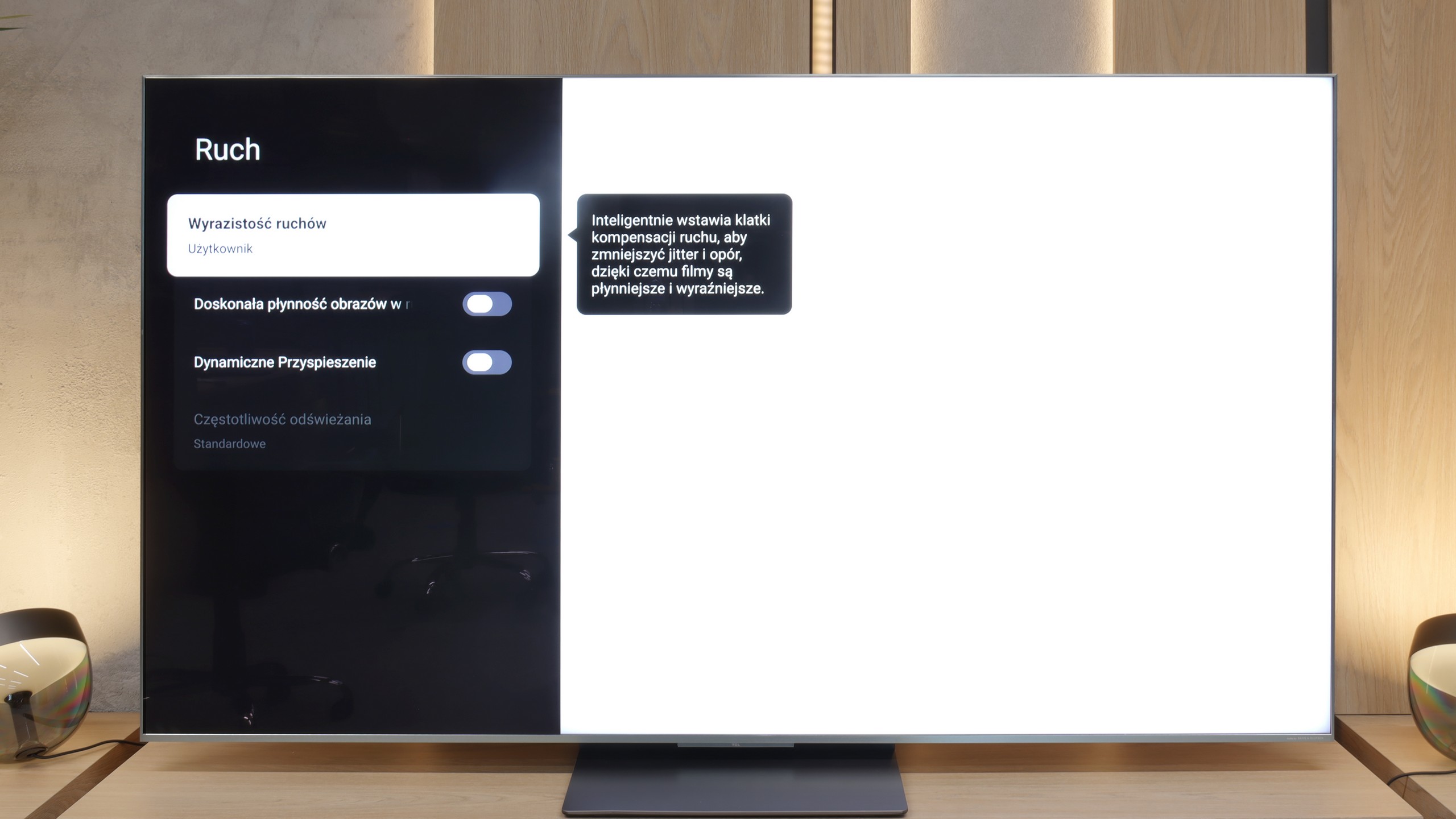
Blur (native resolution, maximum refresh rate):




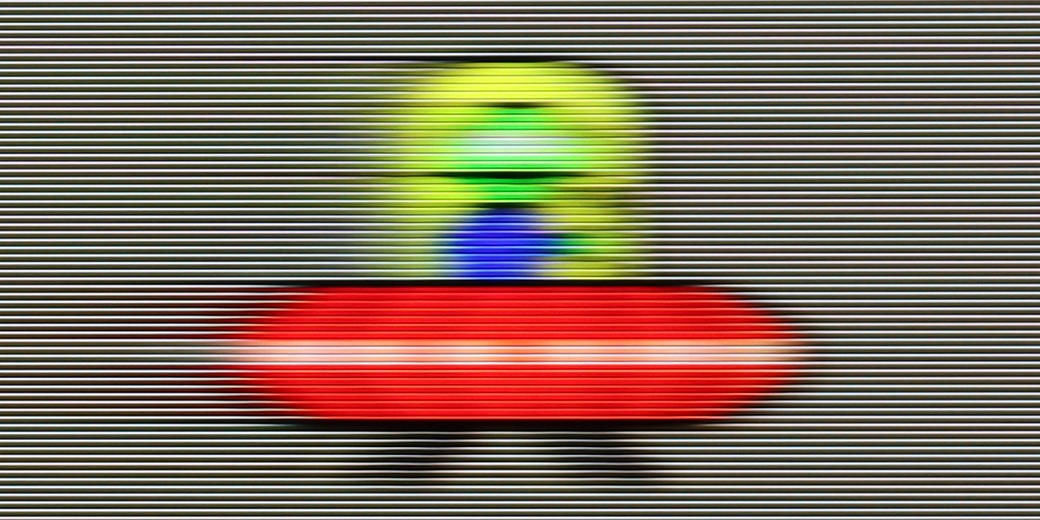
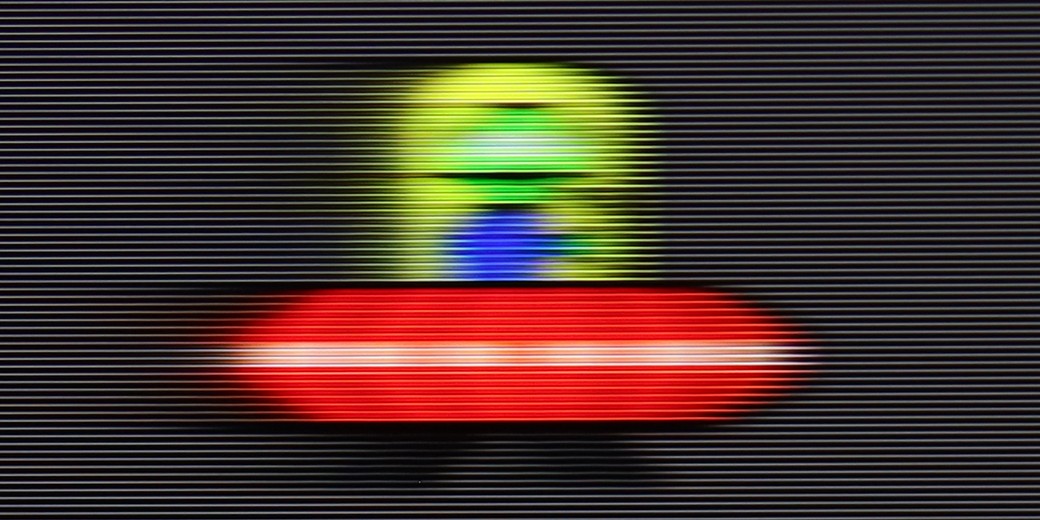
Blur (BFI function enabled):
Image flickers in this mode






Smużenie ():
Smużenie (1080p@288Hz):


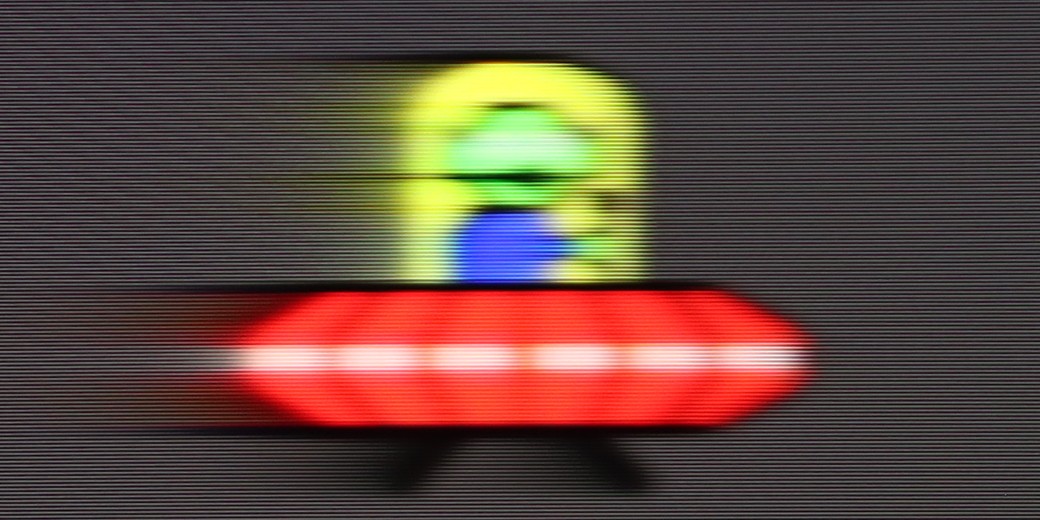
The new feature in The Frame for 2025 is a 144 Hz refresh rate display. Yes – in a television primarily associated with displaying works of art, you can now not only watch Van Gogh, but also comfortably play on a console or follow fast-paced sporting events. This is a significant step towards greater versatility. In the case of Samsung movies, as usual in models with a 120 Hz display and above, it allows you to adjust motion fluidity according to your preferences. You can set a more cinematic reproduction that maintains frame rate or opt for complete image smoothing. The range of options is broad, allowing you to tailor the effect to your tastes – regardless of whether the screening is meant to look like classic cinema or a performance on a modern theatre panel.
*this part of the test refers to the model LS03FAU in sizes 55 and 65 inches, which is equipped with a 144Hz display; the sizes 43 and 50 inches have 60Hz displays, and consequently perform much worse in terms of motion fluidity.
Similar to the C8K, the C9K is also a really fast TV – both figuratively and literally. It features a 4K panel with a refresh rate of 144 Hz, and at lower resolutions, the panel can even ramp up to 288 Hz. Such speed translates into practice – while watching sports or playing games, the image looks very smooth and clear. Additionally, in movies, we get an extra motion smoother called Motion Clarity, which allows you to adjust the smoothness to your own preferences – from cinematic "judder" to almost theatrical smoothness.
Console compatibility and gaming features
8.1/10
9.8/10
- ALLM
- VRR
- VRR range48 - 144Hz48 - 288Hz
- Dolby Vision Game Mode
- Correct implementation of HGIG
- 1080p@120Hz
- 1440p@120Hz
- 4K@120Hz
- Game bar

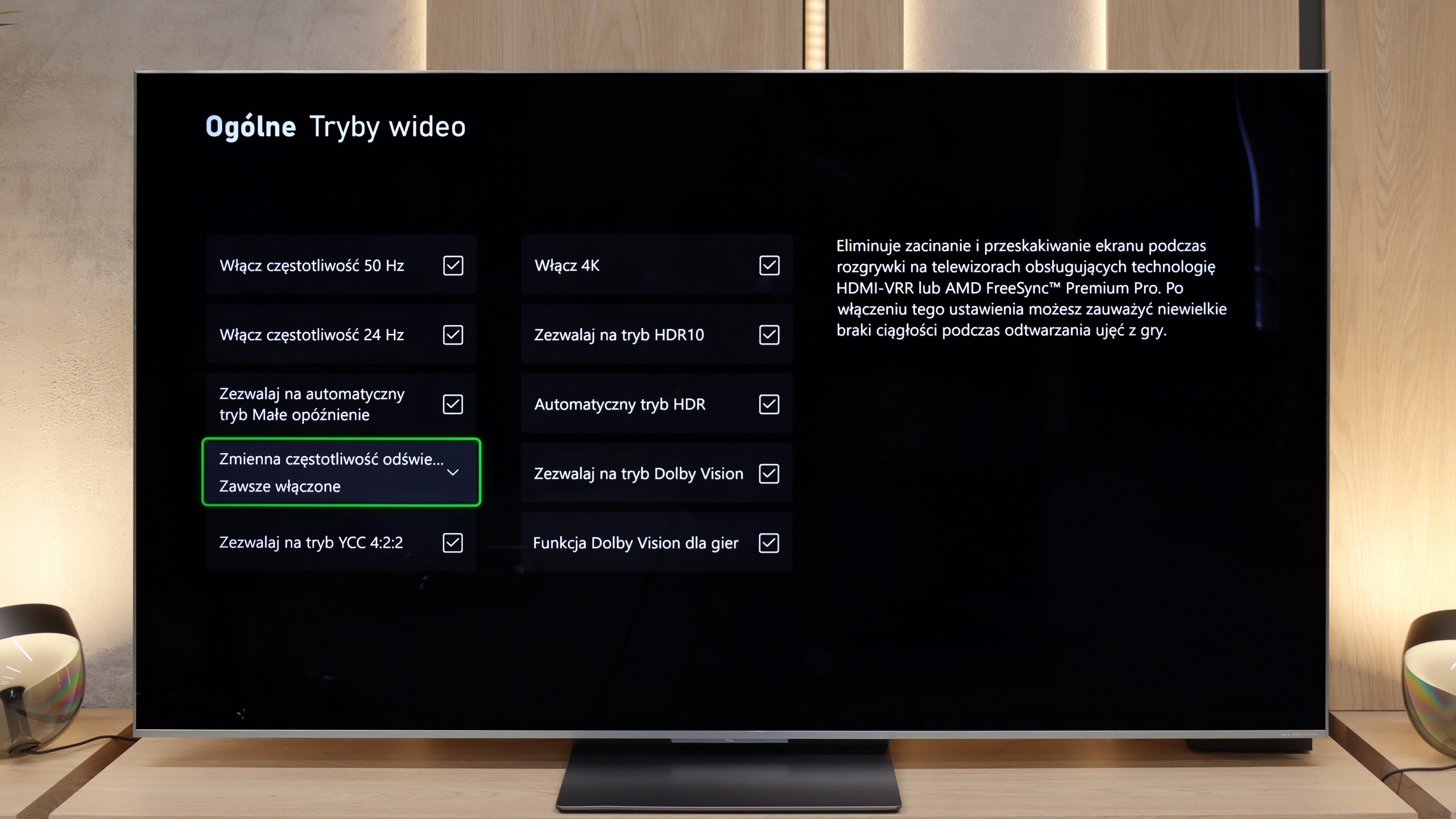

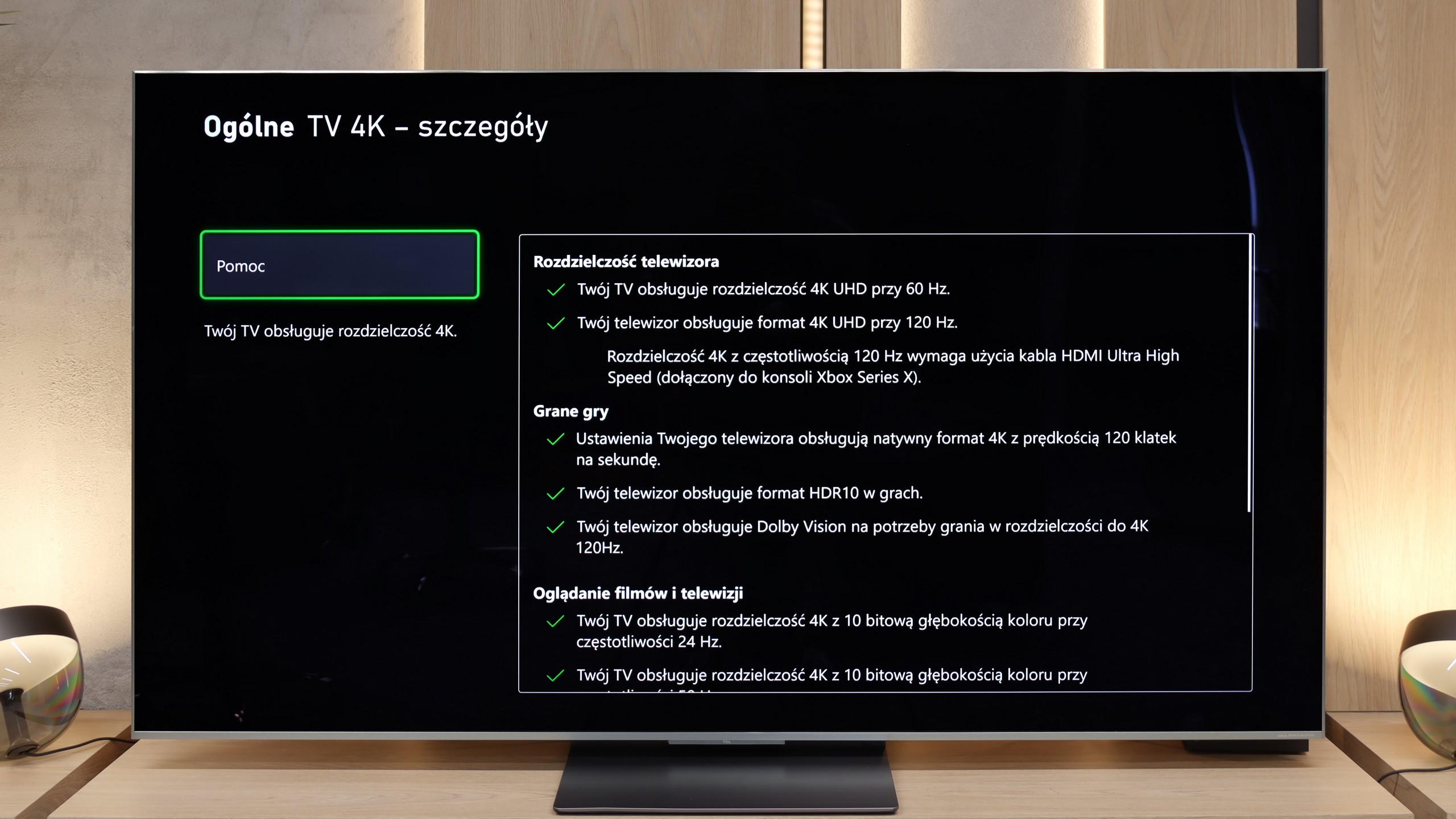

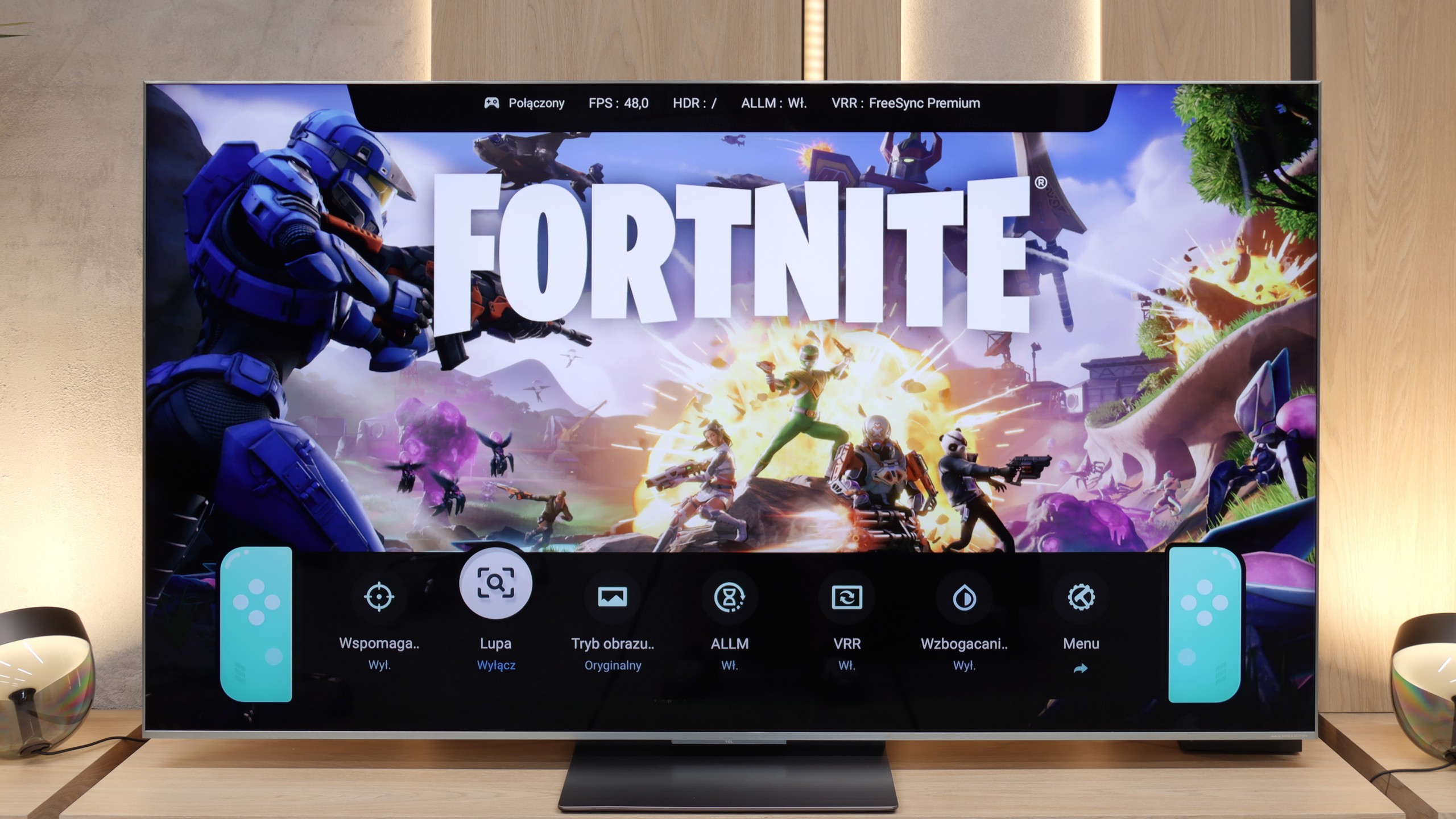

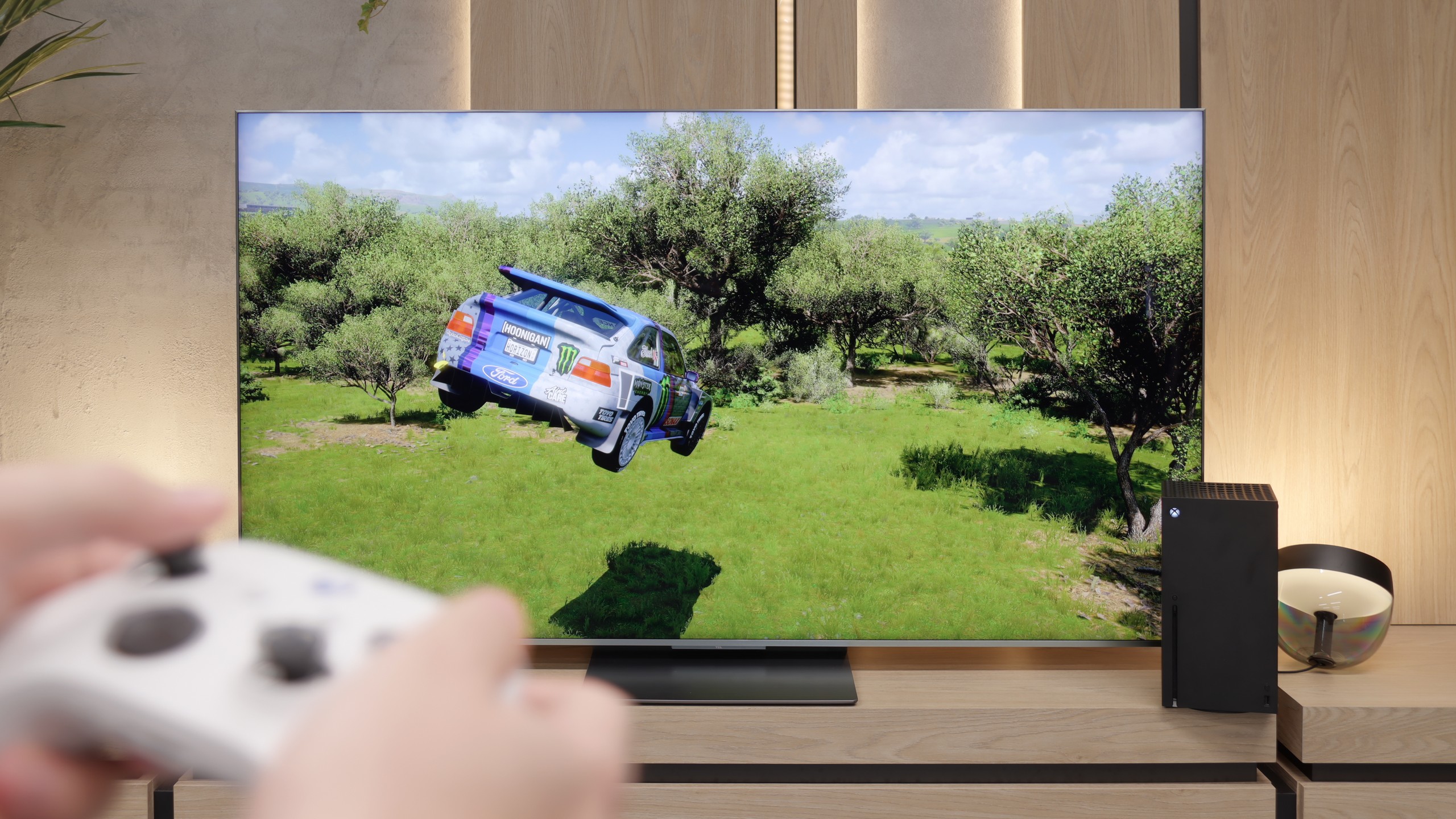
As we mentioned earlier – although The Frame likely displays images and artwork for most of the time, Samsung recognised that a Van Gogh fan could just as easily be an avid gamer. And it must be said that The Frame 2025 has almost everything to become a fully-fledged gaming TV.
Onboard, we find support for ALLM (Auto Low Latency Mode) and Variable Refresh Rate (VRR) thanks to the implementation of a single HDMI 2.1 port. The TV handles lower resolutions at higher refresh rates effortlessly and features an expanded Game Bar – already known from other Samsung models – which allows for quick preview and adjustment of key gaming-related settings. For this, it gets extra points from us. Noteworthy is also the proprietary motion smoother, Auto Motion Plus Game, which – and this is worth emphasising – works without increasing input lag. Samsung remains the only manufacturer that has managed to implement this feature in a practically unnoticeable way regarding delays. The result? Much better fluidity in games, especially those that struggle to maintain a stable 60 frames. This solution can genuinely improve gaming comfort in more demanding titles – particularly on consoles that don’t always manage full fluidity, especially in AAA games.
As for the downsides – the lack of Dolby Vision is already something we consider standard in Samsung TVs, so there’s not much to specifically nitpick here. However, the problem lies elsewhere. In the latest version of the Tizen system, the HGiG option has disappeared. Literally – it’s gone. This is a significant inconvenience when configuring the console for proper HDR content display in games. It's hard to understand why such a decision was made, but one thing is certain – this needs to be fixed as soon as possible. We’re talking about a brand that has set standards for gaming on TVs for years. If HGiG returns – and we hope it does – The Frame LS03F can confidently aspire to be a proper gaming TV. Not only as a decoration on the wall, but as equipment that truly enhances the gaming experience.
From a gaming perspective, the TCL C9K is a complete tool. It features two (out of four) full bandwidth 48 Gbps HDMI 2.1 ports, so all the key technologies work: VRR (Variable Refresh Rate) and ALLM (Auto Low Latency Mode). Additionally, the manufacturer has included a really intuitive Game Bar that allows you to quickly check the most important parameters and adjust settings without fumbling through menus. Also, TCL's policy is a plus – the TV isn’t afraid of any HDR formats, even in game mode. Whether it's HGiG or Dolby Vision for the Xbox Series S/X console – everything works as it should, giving the player plenty of freedom.
Input lag
10/10
9.8/10
SDR
HDR
Dolby Vision
When it comes to input lag, Samsung maintains a very high standard. The LS03F, like most of this year's models from the brand, achieves a score of 8 ms for 4K content, which is practically a benchmark value. This result allows you to play even the most dynamic titles without delays and with complete responsiveness. Well done!
In terms of input lag, the TCL C9K performs exceptionally well. With 120 Hz content, the lag is only 7 ms, placing it among the very top televisions available on the market. Naturally, with 60 Hz materials, the input lag increases to around 15–16 ms, but in practice, this has little impact on the final responsiveness of the screen to our actions on the controller.
Compatibility with PC
8.2/10
8.6/10

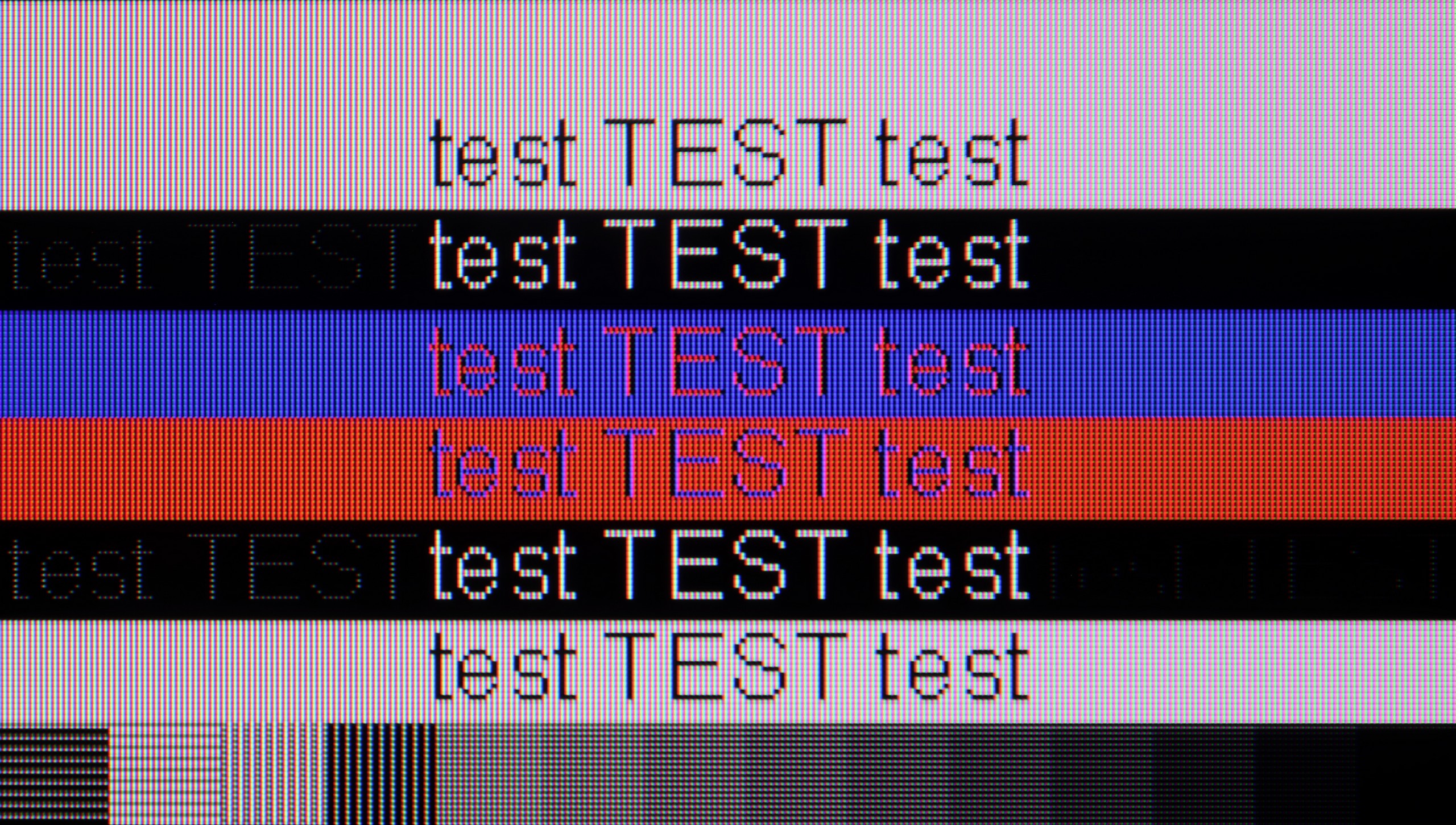
Collaboration of The Frame 2025 with a computer poses no major issues. Let's start with gaming, as this is where this model shows its strengths – support for 144 Hz signal, low input lag, and compatibility with G-Sync technology (for NVIDIA cards) make it hard not to consider it a full-fledged gaming monitor. It’s one of the more interesting "gaming with PC" televisions available on the market in this class.
When it comes to everyday work, the situation looks just as good. The Frame easily handles chroma 4:4:4, which translates to good font readability and overall user comfort. We only noticed slight issues with dimming very thin lines and dark details on a light background – this effect may occur, particularly when working with small interface elements. In practice, however, with a 55-inch screen and standard office working distances, it will be hard to realistically notice this problem. Nonetheless, it's worth keeping this in mind if the television is to serve as a monitor not only for entertainment but also for precise graphic or text work.
When it comes to office work, the TCL C9K does not disappoint – thanks to support for chroma 4:4:4, text readability is at a good level, so typing or working with documents shouldn’t be a problem. While there are some minor issues with dimming horizontal lines, in everyday use it’s hard to call this a real flaw. However, the biggest potential of the C9K reveals itself in PC gaming. Here, the television showcases its full capabilities – it can switch to lower resolutions, such as Full HD, and display images at up to 288 Hz. Additionally, it supports both G-Sync and FreeSync, so synchronisation with the graphics card works excellently. It’s hard to have any significant complaints about this setup – it’s truly a top-tier screen for gaming on a computer.
Viewing angles
3.5/10
4.5/10
As one could expect from a VA panel, the viewing angles on The Frame 2025 are at best mediocre. The image loses saturation and contrast when viewed off-axis. It's a shame, because we're talking about a model that displays digital artworks in standby mode – and it's precisely in such moments that wide viewing angles would make the most sense, enhancing the feeling of interacting with a real piece of art rather than just its screen imitation.
Perhaps in the future, manufacturers will decide to introduce special coatings or modified versions of VA panels that improve this aspect – as it would have real significance not only in terms of functionality but also aesthetics for lifestyle televisions.
A new feature in TCL televisions for 2025 is the WHVA panel, which is designed to provide better viewing angles than standard VA panels. And indeed – progress is noticeable. When viewing the screen from the side, the image is clearer and the colours do not degrade as quickly as in previous models. However, this does not mean that we are encountering the level of top coatings or solutions found in IPS panels, and certainly not OLEDs. The image remains readable, but the brightness noticeably drops. This is definitely a step forward compared to earlier TCL models, but not a full revolution yet.
TV efficiency during daytime
6.3/10
7/10

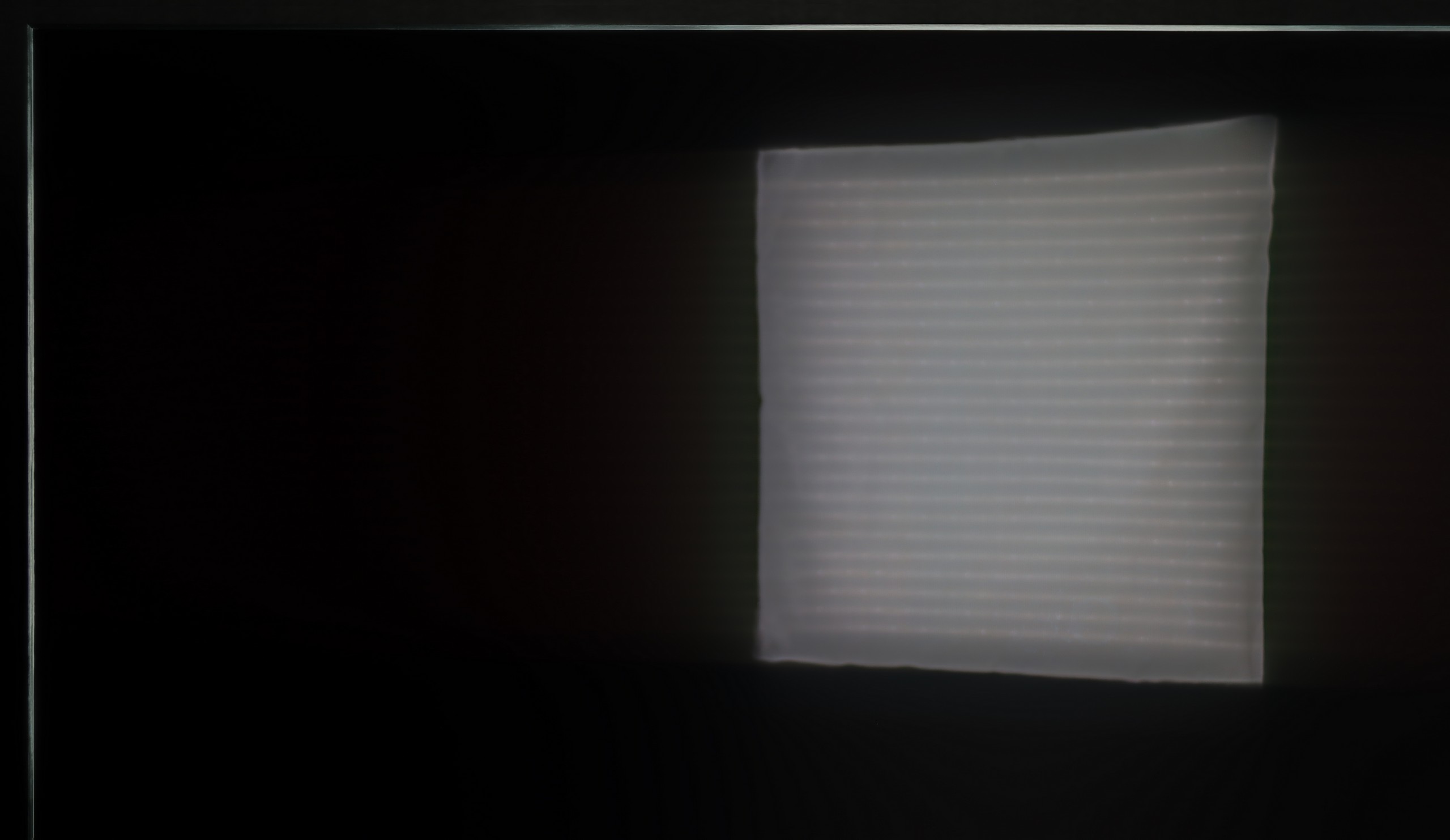


Matrix brightness
Average luminance SDR
TCL C9K: 642 cd/m2
Samsung The Frame 2025 (LS03F): 596 cd/m2
One of the most distinctive features of The Frame is its matte display – and it must be said that Samsung has really perfected this aspect. From our experience, it's one of the best solutions for reducing reflections, especially direct ones. If reflections on the screen can be irritating, it will be hard to find a better screen in this budget than the matte panel used in Samsung TVs. Of course, this comes with a certain compromise. In very bright sunlight, colours may appear slightly faded, and the image loses a bit of depth. However, this is something we consciously accept when opting for a matte screen – you win some, you lose some. In practice, the colours and contrast on Samsung's matte screen still outperform those on Chinese models such as TCL NXT Vision or Hisense Canvas TV. If effective reduction of reflections is a priority and you want to use the TV also as a “digital artwork” in bright rooms, it’s hard to make a better choice.
The Frame achieves around 600 nits of brightness, which, combined with the matte coating, ensures that the TV performs well in well-lit daytime conditions. It may not be at the level of flagship models, but in everyday use – in a living room with plenty of light – it handles it without any problems.
The new WHVA matrix coating has its strengths and weaknesses. On one hand, it handles smaller reflections quite well, but on the other hand, with stronger light sources, it shows that the suppression of reflections isn't at the highest level. Fortunately, the coating doesn't ruin what's most important: the blacks and colour saturation. This is definitely a plus, as in many competing models, compromises in this area are much more painful. Additionally, it has very high brightness – in SDR content, the C9K can achieve an average of 650 nits in SDR materials. This performance is more than sufficient for watching TV or films in challenging lighting conditions, even on a sunny day.
Details about the matrix
Subpixel Structure:

Panel uniformity and thermal imaging:

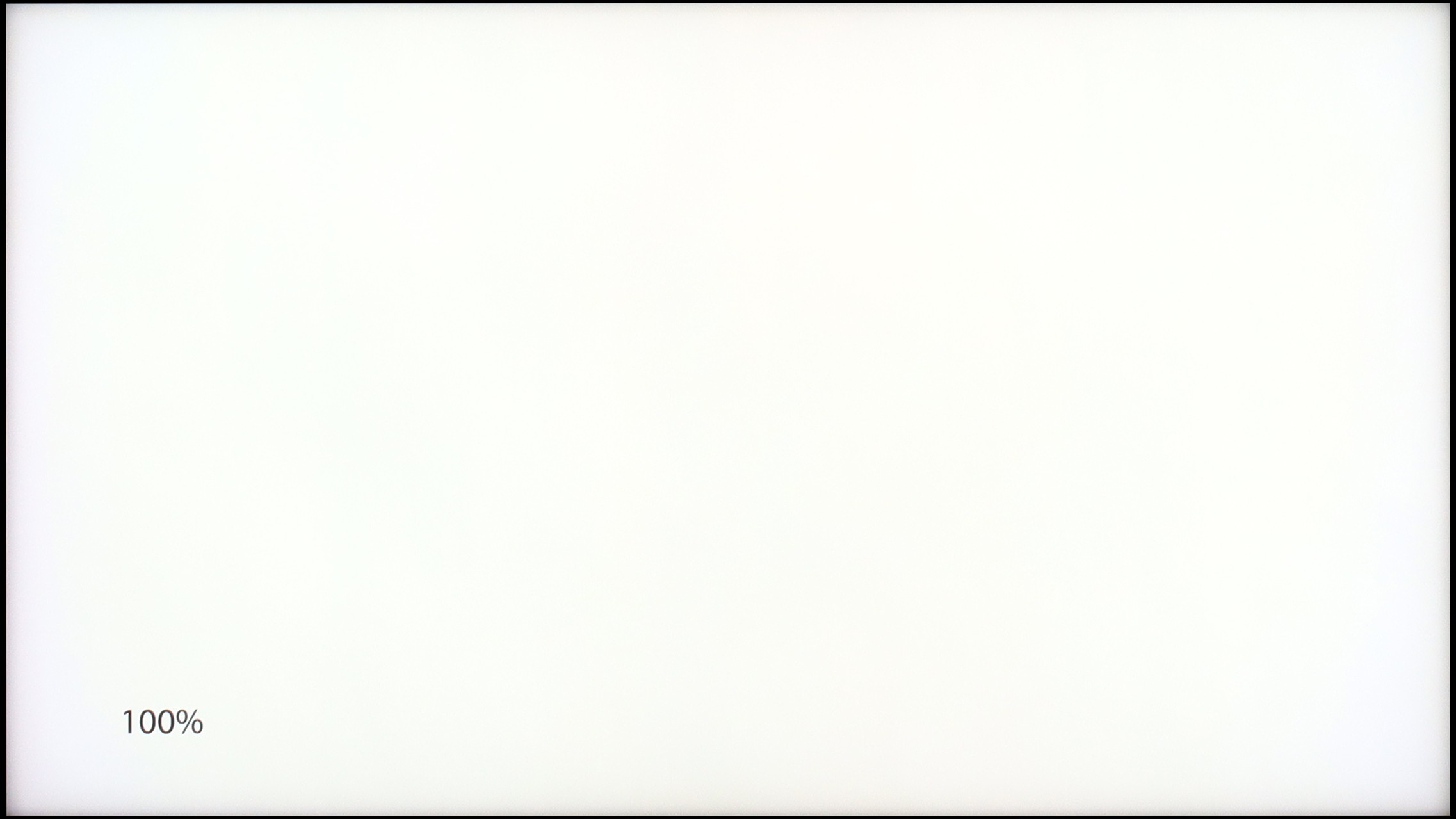
Samsung The Frame 2025 (LS03F)
TCL C9K
TV features
7.2/10
7.7/10
- HDMI inputs3 x HDMI 2.0, 1 x HDMI 2.1 40Gbps2 x HDMI 2.0, 2 x HDMI 2.1 48Gbps
- OutputsToslink (Optical audio), eARC (HDMI), ARC (HDMI)Toslink (Optical audio), eARC (HDMI), ARC (HDMI)
- Network InterfacesWi-Fi 2.4GHz, Wi-Fi 5GHzWi-Fi 2.4GHz, Wi-Fi 5GHz, Ethernet (LAN) 100Mbps
- TV receptionDVB-T, DVB-T2, DVB-S, DVB-S2, DVB-CDVB-T, DVB-T2, DVB-S, DVB-S2, DVB-C
Classic features:
- Recording to USB (terrestrial TV)
- Recording programming
- Picture in Picture (PiP)
- RF remote control (no need to aim at the screen)
- Backlit remote control
- Teletext
- Audio only mode
- Possibility to connect Bluetooth headphones to the TV
- Possibility to simultaneously use Bluetooth headphones and the TV speaker
Smart features:
- AirPlay
- Screen mirroring (Windows Miracast)
- Wyszukiwanie głosowe
- Voice search in native language
- Ability to connect a keyboard and mouse



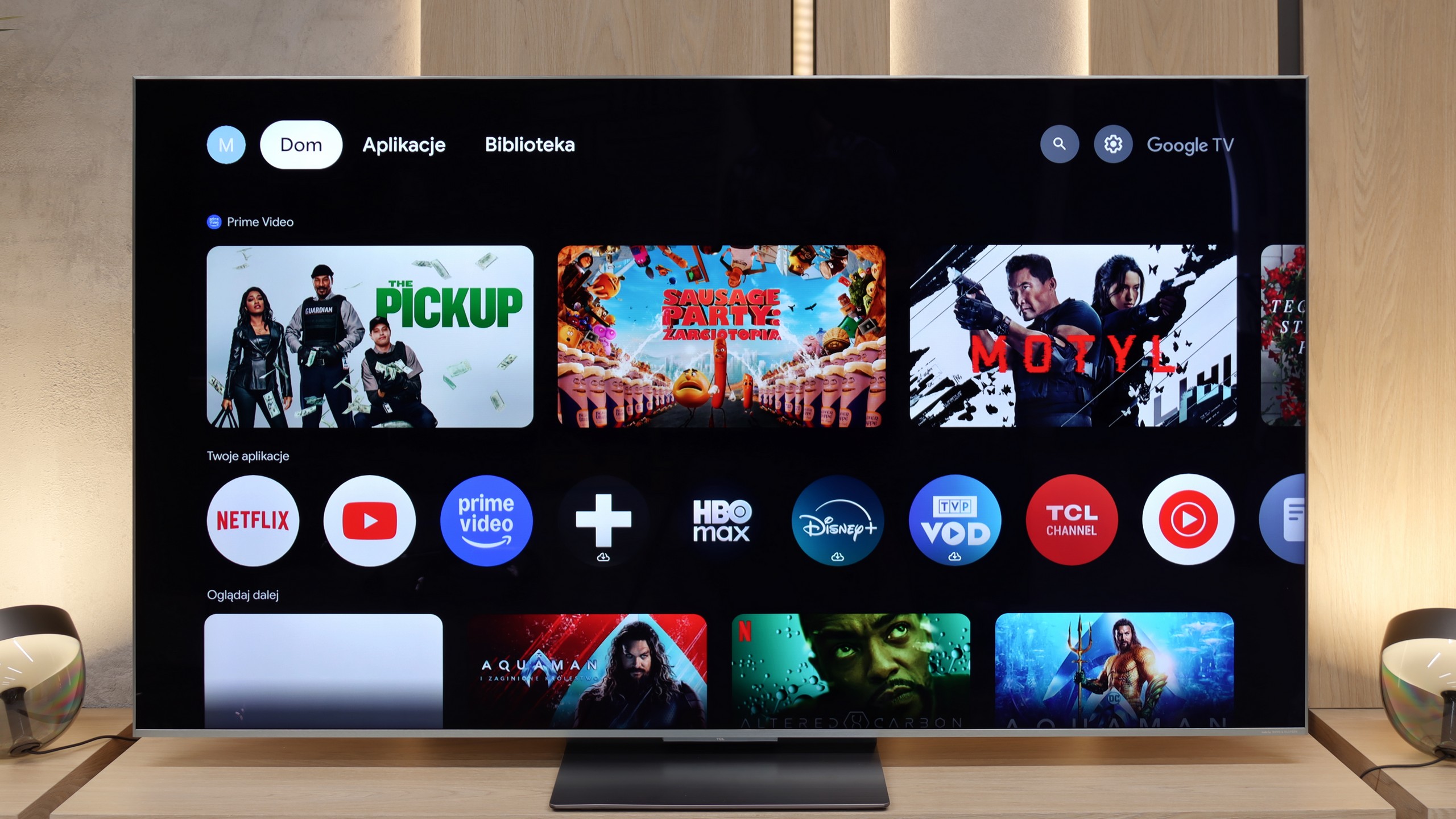
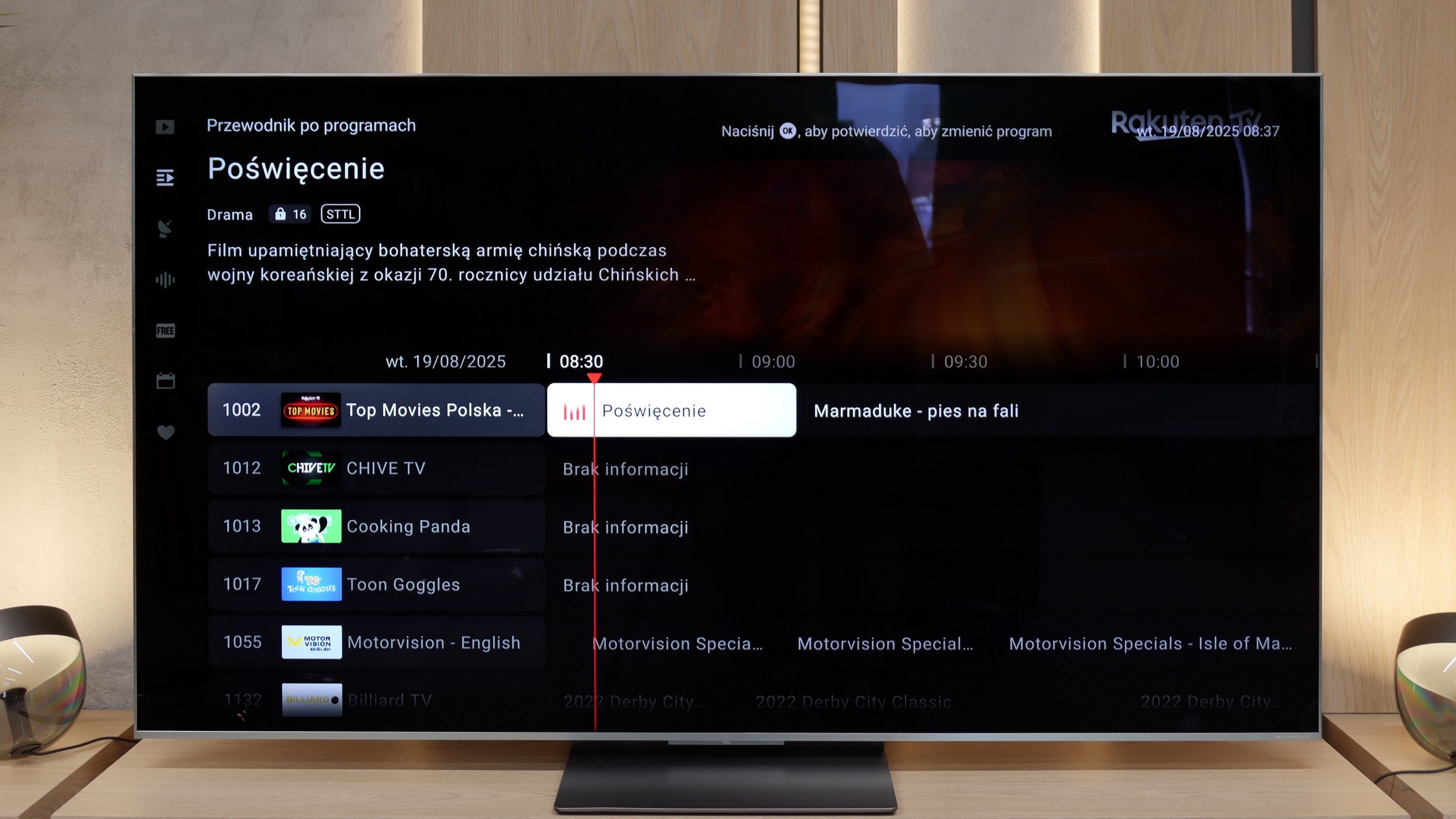
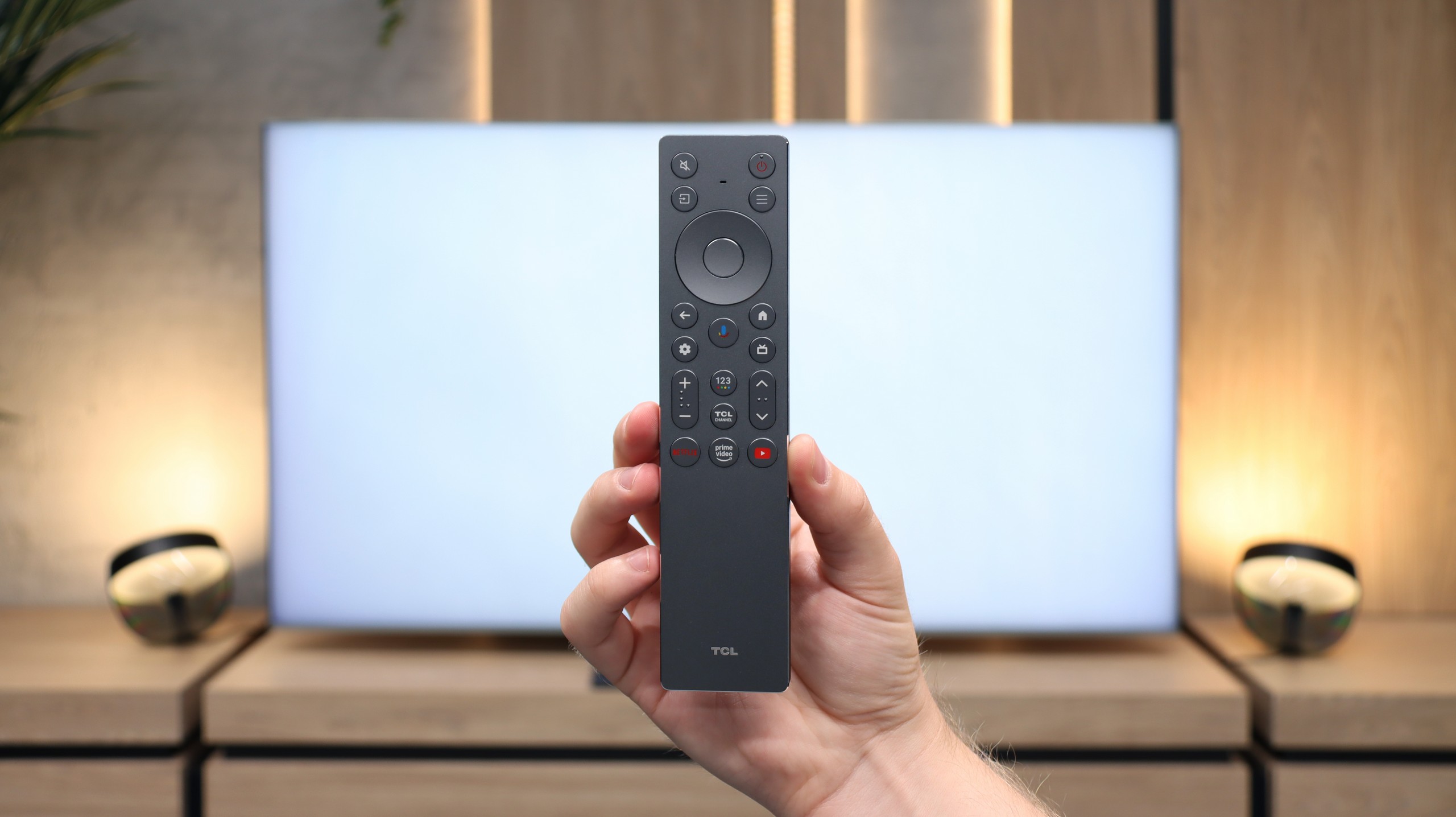
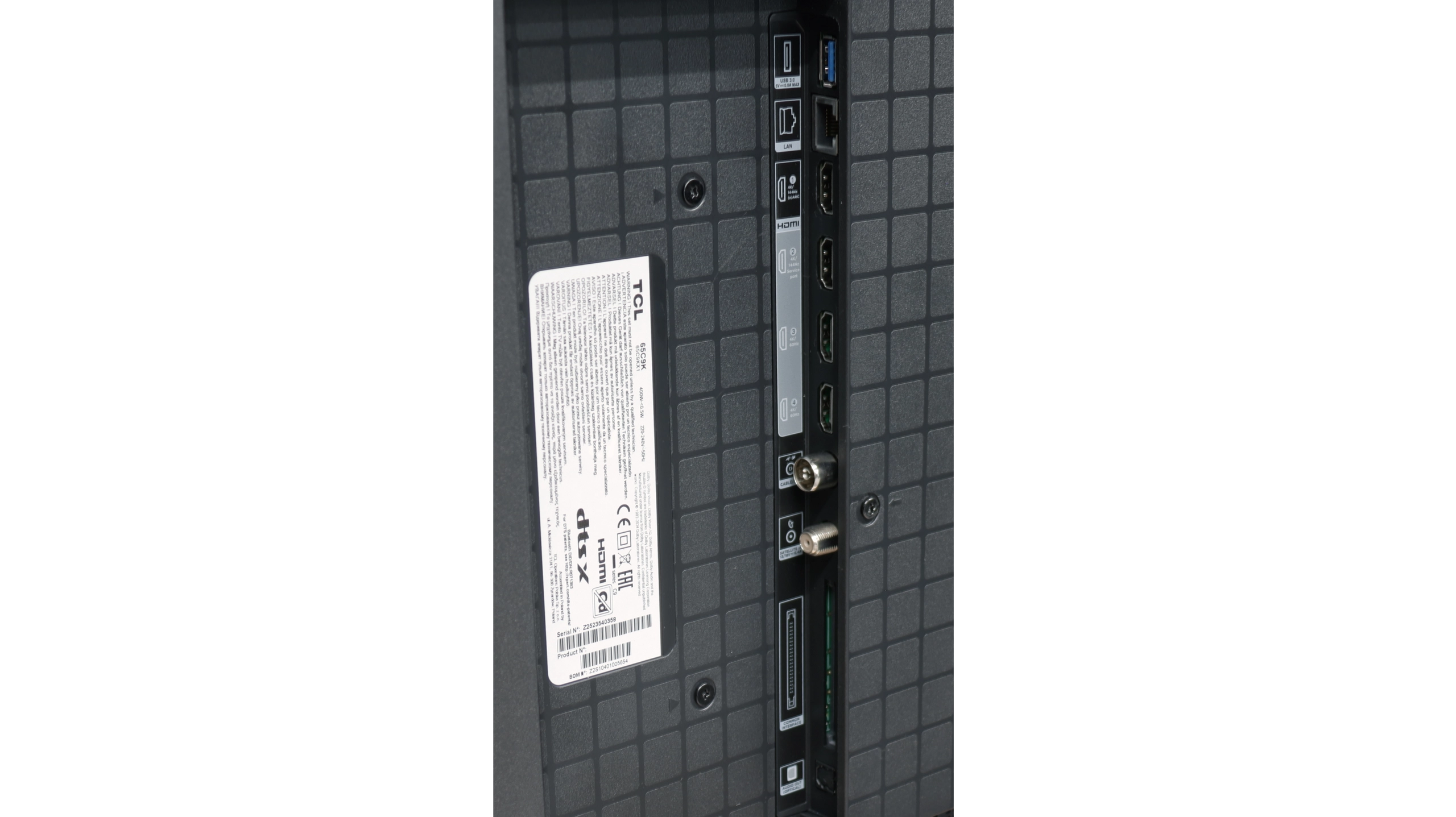
Classic TV Features
In terms of classic features, The Frame doesn’t stand out in any significant way compared to its competitors. There’s no option for USB recording or PiP (picture in picture), which may be disappointing for some users. On the other hand, the TV allows simultaneous use of speakers and headphones, which can be useful – especially for older users. The EPG, or electronic programme guide, is quite readable, and despite the absence of traditional buttons on the remote, we managed to launch even the teletext. In everyday use, the basic functions work smoothly and without major complaints.
Smart System – Tizen and Apps
The Frame 2025 runs on the Tizen system, which has been regarded as one of the most refined Smart TV solutions on the market for years. It’s a system designed for devices that are more than just a television – and it has been designed with this spirit in mind. Tizen offers full integration with external devices – supporting both Apple AirPlay and Miracast. Thanks to the SmartThings app, it’s possible to control not only the television but also other devices within the smart home framework. Since last year, Samsung has also been developing its own voice assistant with support for the Polish language, which significantly facilitates operation. However, the greatest strength of the Smart system in The Frame remains the Art Gallery app. Although access to it is paid (via subscription), it offers the best art scans on the market – we’re talking about scans, not just ordinary photos. This makes the effect of a digital painting hanging on the wall appear significantly better than in any other lifestyle TV.
Classic TV Features
In terms of basic TV functions, the TCL C9K does not disappoint – it has everything that most users expect. The EPG guide operates smoothly, teletext is available, and pairing Bluetooth headphones, a mouse or a keyboard goes off without a hitch. However, it should be noted that in the Google TV system – just like in other TCL models – there is a lack of more advanced options such as programme recording or picture-in-picture (PiP) mode. Some people may find this unsatisfactory, especially if they have used such features with competitors. It's also worth mentioning that we only have one USB port – it's enough to connect a hard drive with movies or a USB stick, but if someone plans to use multiple storage devices, they may find this lacking.
Smart Features
While in terms of classic solutions the TCL C9K does not stand out, in the field of smart functions it showcases its full potential. The Google TV system is currently the most popular platform and it’s clear why – the app library is enormous. Netflix, YouTube, Disney+, HBO Max, Amazon Prime Video – all are readily available. Only those very attached to more closed ecosystems, like Apple Music, will feel the absence. A significant advantage is the built-in voice assistant – it works quickly, understands natural commands, and allows for convenient control of the TV: from switching channels to opening apps, as well as searching for content or checking the weather. It’s in this area that the TCL C9K shows that a smart TV is more than just a “TV with internet” – it’s a tool that genuinely simplifies everyday use of the device.
Playing files from USB
9.1/10
9.2/10
Supported photo formats:
Maximum photo resolution:

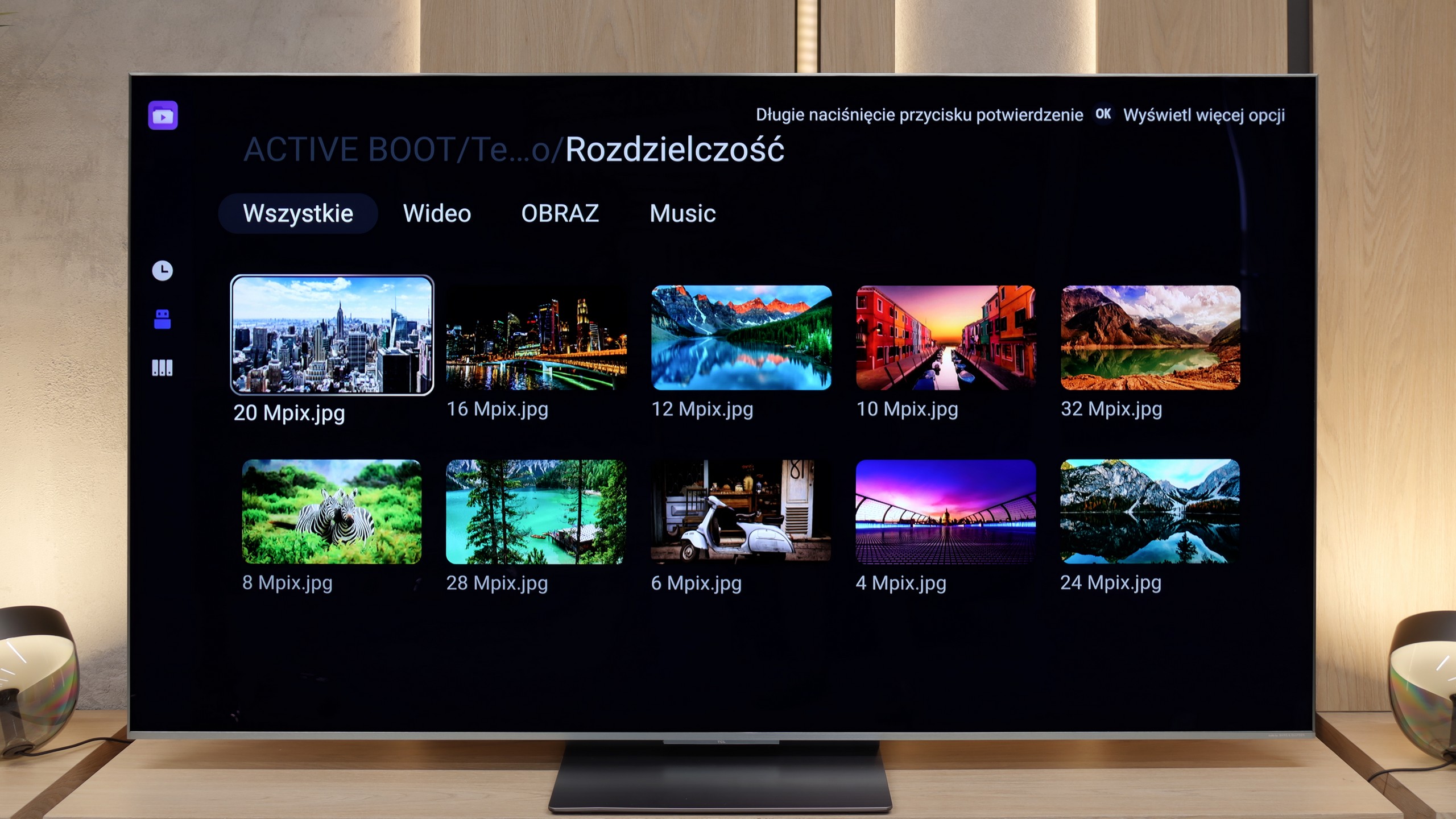
During testing, we didn't notice any major issues with playing files from a USB memory stick. The television handled both video materials and photos well. Of course, there are some exceptions – for example, the lack of support for the HEIC format (used by Apple devices) – but it's hard to consider this surprising. On the positive side, it fully supports high-resolution photos – the television displays high megapixel files without any problems, which can be significant for those wanting to treat The Frame as a digital photo frame as well. However, during testing, we noticed a limitation regarding subtitles – the television only correctly handled files in .txt format. It's worth keeping this in mind and ensuring that downloaded subtitles for films are saved in this format; otherwise, they may simply not display.
The C9K had no trouble handling most of the materials we threw onto the USB drive – from MKV formatted films, through older AVI files, to audio tracks in DTS and FLAC. The only issue remains the lack of support for HEIC photos from Apple devices, but this is a problem for practically all manufacturers. However, the most important thing is that if someone is missing support for some exotic format, they can always reach for an alternative player available in the Google Play store. And this is where the advantage of the Google TV system shines through – the ease with which you can expand the television’s capabilities with additional applications.
Apps
8.7/10
9.6/10














































Sound
6/10
7.9/10
- Maximum volume-77dB
- Dolby Digital Plus 7.1
- Dolby True HD 7.1
- Dolby Atmos in Dolby Digital Plus (JOC)
- Dolby Atmos in Dolby True HD
- DTS:X in DTS-HD MA
- DTS-HD Master Audio
For such a slim television, the sound is quite decent. It’s full, adequate for everyday viewing, but lacks much excitement – typical of flat designs. There's not much bass, although at times it can be heard. The speakers in a 2.0.2 configuration have a total power of 40 W. (in the 55+ inch version) Unfortunately, the television does not support DTS format, so for movies with that sound, you'll need to rely on external equipment, like a home theatre system. You can connect a soundbar, and thanks to the Q-Symphony feature, the television plays along with it. Samsung also offers visually matching models for The Frame like S700D or S800D, but they are sold separately. (This shouldn’t really surprise anyone😉).
The sound in the TCL C9K is handled by the same setup as in the C8K model – prepared in collaboration with Bang & Olufsen. It features a 4.2.2 configuration with a total power of 90 W, consisting of eight speakers arranged to create a fuller sense of space. And I must admit – the effect is impressive. The dialogues are clear, the highs and mids sound pure, and the bass does not falter, even during louder screenings. Of course, this won't replace a dedicated soundbar or home theatre system, but for built-in speakers – there’s really something to listen to.
*During maximum volume tests, we noticed unusual behaviour from the audio system. With the slider set to 100%, the television reaches around 76–78 dB, but it’s clear that it tries to generate more power, after which the sound level is immediately corrected back to the mentioned value. On the other hand, when we lower the volume to, say, 70%, it initially decreases as expected, but after a moment, it slowly rises back up to that same level of 76 dB. This effect gives the impression of an aggressive limiter at work, which regardless of the slider position always brings the volume back to a single level. We checked this behaviour multiple times, and in each case, the result was the same – no additional functions for 'intelligent' volume adjustment or AI were active during these tests.
Acoustic Measurements
No acoustic data
77dBC (Max)
75dBC


